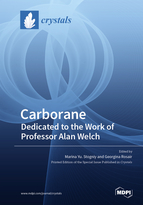Carborane: Dedicated to the Work of Professor Alan Welch
A special issue of Crystals (ISSN 2073-4352). This special issue belongs to the section "Inorganic Crystalline Materials".
Deadline for manuscript submissions: closed (20 August 2021) | Viewed by 18556
Special Issue Editors
Interests: carboranes; metal complexes of polyhedral boron compound
Special Issues, Collections and Topics in MDPI journals
Special Issue Information
Dear Colleagues,
The discovery of polyhedral boron hydrides, including carboranes, was one of the most significant discoveries of 20th-century chemistry. Since then, many different derivatives of carboranes have been obtained and they remain the focus of intense research. The unusual physical and chemical properties of polyhedral boron compounds find a wide range of real and potential applications ranging from medicine to supramolecular chemistry, catalysis, and the design of new materials.
This Special Issue is devoted to research in the field of fundamental properties of, and prospects for using, polyhedral boron hydrides and, in particular, carboranes.
In this context, the aim of this Special Issue, entitled “Carboranes”, is to provide a comprehensive overview of new developments in the chemistry of carborane derivatives with special focus on their structures.
We are pleased to invite you to submit a manuscript to this Special Issue. We welcome original research papers, communications, and reviews.
Dr. Marina Yu. Stogniy
Dr. Georgina Rosair
Guest Editors
Manuscript Submission Information
Manuscripts should be submitted online at www.mdpi.com by registering and logging in to this website. Once you are registered, click here to go to the submission form. Manuscripts can be submitted until the deadline. All submissions that pass pre-check are peer-reviewed. Accepted papers will be published continuously in the journal (as soon as accepted) and will be listed together on the special issue website. Research articles, review articles as well as short communications are invited. For planned papers, a title and short abstract (about 100 words) can be sent to the Editorial Office for announcement on this website.
Submitted manuscripts should not have been published previously, nor be under consideration for publication elsewhere (except conference proceedings papers). All manuscripts are thoroughly refereed through a single-blind peer-review process. A guide for authors and other relevant information for submission of manuscripts is available on the Instructions for Authors page. Crystals is an international peer-reviewed open access monthly journal published by MDPI.
Please visit the Instructions for Authors page before submitting a manuscript. The Article Processing Charge (APC) for publication in this open access journal is 2600 CHF (Swiss Francs). Submitted papers should be well formatted and use good English. Authors may use MDPI's English editing service prior to publication or during author revisions.
Keywords
- carboranes
- metallocarboranes
- polyhedral boron compounds
- fundamentals
- applications







